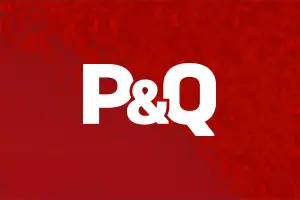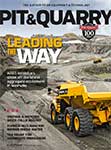Author
Screen at work since World War II
In this business, we often hear stories of equipment still working strong after decades of use. Aggregate producers and equipment manufacturers take pride in telling stories, for instance, of the primary jaw that has been crushing for 40 years or the wheel loader that has worked the quarry since grandpa first fired it up in the 1960s. One such tale comes from Haver & Boecker about a Tyler brand vibrating screen that has played an important role at Canadian aggregates operations for more than 70 years. The R.E. Law Crushed Stone quarry near Port Colborne, Ontario, bought the Tyler F-Class screen in 1943, and the machine, along with the quarry, was sold to Hard Rock Paving Co. in 1977. The Waterford Group bought the operation in 2008 and now uses the screen at a quarry in Uxbridge, Ontario. Its operators say it still works flawlessly. “It’s one of the best-running machines on the site,” says Brandon Smith, Waterford Group site supervisor. “When it was put in my care last spring,… Keep Reading
Our industry in 3-D
It was just a matter of time. Just a matter of time before 3-D printing went from being a novelty to becoming a practical tool. And just a matter of time before 3-D printers became affordable to businesses. Well, the time is now. In 3-D printing, also known as additive manufacturing, layers of material are formed under computer control to create an object. The 3-D printer makes an exact copy of a part in plastic, which can then be used to create a mold if a material other than plastic is desired. According to an article by comedian and car enthusiast Jay Leno in Popular Mechanics, some machines can even make replacement parts in cobalt-chrome with the direct-laser sintering process. Just feed a plastic wire (for a steel part you use metal wire) into the appropriate laser cutter. "Let's say you have an older Cadillac or a Packard, and you can't get one of those beautifully ornate door handles," Leno says. "You could go to the big swap meet in… Keep Reading
From playtime to career
It's finally spring, time for kids to play outside after being cooped up indoors over the long winter months. With Extreme Sandbox, now adults get to play, too. Extreme Sandbox provides guests with an opportunity to operate real construction machines. The adventure takes place in a 10-acre “sandbox,” with training supervision from expert instructors who help provide a fun and memorable experience. This week, Extreme Sandbox and Komatsu America Corp. announced an exclusive equipment sponsorship agreement that enables both companies to expose more Americans to the experience of operating big machines. In addition to the fun it provides, the partnership will introduce a new generation to heavy equipment and the potential of a rewarding career. "We see tremendous value in using ‘fun’ to get students excited about the heavy equipment trades, as well as letting the general public experience what it is like to operate this type of equipment," says Randy Stenger, founder & CEO of Extreme Sandbox. Rich Smith, vice present, Product and Services Division for Komatsu America, adds,… Keep Reading
Cone crusher utilizes Symons principle
In booth 2214 at AGG1, McLanahan Corp. discussed its new cone crusher, which operates on the Symons principle, and is designed to provide a balance of high performance and long service life. Called the MSP (McLanahan Symons Principle), the new crusher offers features such as a balanced eccentric, higher speeds, fulcrum point position and stroke. A balanced eccentric coupled with a fulcrum point ideally placed over the crushing chamber yields highly effective compression crushing, allowing higher eccentric speeds to maximize performance without disruptive forces. The eccentric stroke is designed to work with the speed and fulcrum position to produce higher product yield and minimize recirculating loads. The company says the torque and resulting crushing forces are as effective as virtually any cone crusher currently on the market. By creating a more effective compression crushing, the MSP cone crusher also reduces liner wear, reducing wear costs, allowing higher product yield and resulting in decreased overall cost per ton of finished product. Watch this video to learn more about McLanahan's new equipment. Keep Reading
Pit & Quarry’s redesign roadmap
It’s been a long time coming and a lot of work to make happen, but the new Pit & Quarry is here. From the front cover to the Looking Back page (now called A Look Back), our brand has a brand-new look. And the look is not all that has changed. Based on your valuable feedback, we’ve made content updates, as well, and following is a kind of roadmap to help you find your way. Contents: Your most detailed roadmap is the monthly Contents section, which we’ve expanded to two pages. News: The latest news, as always, is posted on our website, social media sites and in our weekly enewsletter. You told us you still want news in the magazine, and we have it. Up to Speed, near the front of the book, brings you up to speed on the most important happenings. Equipment- and manufacturer-related news is in the P&Q Tech Update section. Economics news, including David Chereb’s monthly Aggregates Forecast, the P&Q Aggregates Industry Index and expanded Stocks… Keep Reading
Summit to acquire Boxley Materials
Summit Materials Inc. signed a definitive agreement to acquire Boxley Materials Co., a vertically integrated construction materials company founded in 1892 and based near Roanoke, Va. The transaction is expected to close in mid-March, pending expiration of the standard regulatory review period. Together with the recent acquisition of American Materials Co. (AMC), Boxley forms a strong aggregates-based growth platform for Summit in the Virginia and Carolinas region. The combined businesses comprise 11 aggregates locations with 0.5 billion tons of reserves and annual sales volume of about 5 million tons, along with four asphalt plants, four ready-mix concrete plants and one architectural-products manufacturing facility. The combined investment is approximately $250 million. Tom Hill, Summit's CEO, says, “These high-quality businesses are a perfect fit with our materials-based acquisition strategy, increase our geographical diversity and create a platform of scale in the high-growth Mid-Atlantic area. Both possess market leading positions and experienced and entrepreneurial management who will continue to be led by Ab Boxley at Boxley and Tim Bizzell at AMC." Keep Reading
USGS: Aggregate production rose estimated 4.5 percent in 2015
The U.S. Geological Survey (USGS) estimates that about 2.25 billion metric tons of construction aggregate, valued at more than $21 billion, was produced in 2015. This represents a 4.5 percent increase over 2014 totals. Jason Christopher Willett of USGS reports that in 2015, 1.32 billion metric tons of crushed stone was produced by 1,430 companies operating 3,700 quarries, 82 underground mines and 187 sales/distribution yards. The estimated value is more than $13.8 billion. Leading states were, in descending order of production, Texas, Pennsylvania, Missouri, Florida, Ohio, Illinois, Kentucky, Indiana, North Carolina and Virginia, which together accounted for more than half of the total crushed stone output. Of the total domestic crushed stone produced in 2015, about 70 percent was limestone and dolomite; 13 percent, granite; 6 percent, traprock; 5 percent, miscellaneous stone; 4 percent, sandstone and quartzite; and the remaining 2 percent was divided, in descending order of tonnage, among marble, volcanic cinder and scoria, calcareous marl, slate and shell. It is estimated that of the crushed stone consumed in… Keep Reading
Cleaning up its act
It’s a piece of legislation that is sure to get vetoed if it passes the Senate, and would likely turn into a partisan mess if it ever actually became law, but the basic idea behind the SCRUB Act is a good one. Officially known as the Searching for and Cutting Regulations that are Unnecessarily Burdensome Act, it passed the U.S. House of Representatives this month by a vote of 245-174. If it were to somehow become law, the SCRUB Act would establish a bipartisan commission to review existing federal regulations and identify rules that should be repealed. Specifically, the bill establishes the Retrospective Regulatory Review Commission to review rules “that impose paperwork burdens or unfunded mandates that could be reduced substantially without significantly diminishing regulatory effectiveness, that impose disproportionately high costs on small entities, or that could be strengthened in their effectiveness while reducing regulatory costs.” In other words, the idea is to simplify and/or get rid of regulations that are outdated and ineffective, such as some of those imposed… Keep Reading
Evolution of an industry
On the 10th floor of our offices on Cleveland’s East Ninth St. – also known as Rock & Roll Blvd. – is a large bookcase that holds several bound volumes. Dating back to 1917, each volume contains a year’s worth of Pit & Quarry issues, and in them is essentially a recorded history of the aggregates industry in North America for the past 100 years. The 1916 issues are missing, as well as a few others, but most all of it is there, right at our fingertips. So in this, our 100th anniversary year, we’ve decided to share it, through our Pit & Quarry Evolution Series. It begins on page 18 of this issue, and each month of 2016 it will detail the many decades worth of changes experienced by one sector of our industry, such as this month’s topic – drilling and blasting. Other areas of focus in the coming months will include loading and hauling, trade shows, crushing, safety and much more. And along with your June 2016… Keep Reading












